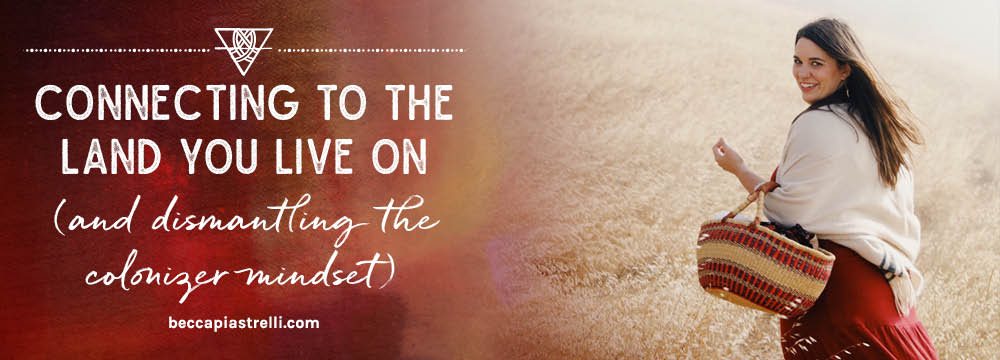
When I began my journey with plants and herbs in a more serious way, I unknowingly had a disconnection from the land I was living on.
I was purchasing dried herbs from online shops who were sourcing them from all over the world. I was buying flowers at my local grocery store who was shipping them in from South America. I was drinking teas that were sourced in from far away lands that weren’t my own.
I was passionate about the preservation and tending to the earth, but I wasn’t connected in even the simplest of ways to the land I was living on.
If someone pointed to a tree or native weed poking out of the cement, I couldn’t tell you what its name was. I was a plant lady who didn’t’ know her own bio-region. I had my nose in herb books and was dreaming of misty meadows and craggy cliffs in the lands of my ancestors. All while living in my little apartment in Oakland, California (Ohlone tribal land).
It was at the urging of some dear teachers of mine and people I followed who I greatly admired that I finally took the time and care to understand and embrace the land I live on now. Because, the fact of the matter is, I do love living here and I am committed to shifting my colonizer mindset of taking without reciprocity (giving in return) to being the most responsible, aligned dweller of this land as I can. I am here to be a good ancestor (thank you Quw’utsun Made for that saying).
If you are looking to cultivate a reciprocal and reverent relationship with the land you live on (whether it’s in a city apartment, suburban townhouse, or a cottage in the woods), here are some things I’ve learned and used to tend to that desire:
1. Know the name of the people who were the original ancestors of your land (I share more about this here). Go deeper and research the names they used for the rivers, mountains, lakes, and prairies nearby. Research their sacred sites and find out their history leading up until today. Then, find a way to make cultural reparations to their living descendants with your time, money, or ability to educate/be educated.
2. Look up or get a book that shares the names of the native plant and animal species of your area. Practice identifying them when you’re outside—that pesky weed in your garden just might be an edible native that nourished the bodies of the ancestors of that land thousands of years ago.
3. Eat the plants that grow in the soils of your land. Practice making teas and jams and medicines with the plants. If you are wild foraging them, be sure to ask permission before you take (and respect if you receive a no) and never harvest so that less than one-third of the plant remains. You can also collect or buy seeds of native plants and cultivate them on your own in a garden or pots.
4. Make regular offerings to the beings of the land—the animals, the ancestors, the land spirits, the fairies (whatever feels real and true for you). An offering can be an extra plate of food out at dinner or a makeshift altar of found objects when you’re out on a walk. My friend Erin makes an offering of the first harvest of fruit from her garden each season to the spirits of her land. This is tuning into this idea of reciprocity again—dismantling the colonizer mind of taking without giving anything in return. This sacrifice she makes every year is small yet powerful in connecting her to her land (and she lives in an urban setting!).
5. Have gatherings on the land. Invite everyone to bring a dish inspired by the place they live and sourced locally from farms or their gardens. Take time to thank the ancestors and then eat of the land. Let your laughter and joy ripple through the soils beneath you.
So many of us navigate the world without remember to be in our bodies and connected to the natural world around us. When we can bring deeper attention to the trees, the stones, the animals, and the ancestors of the place we are physically stepping foot on, we can heal so many wounds we feel around not belonging. We are fully present with the place we came from—the wild, itself.
Indigenous belief is that, wherever you walk, you are walking on the bones of their ancestors. This doesn’t just mean the people, but also the trees and plants and animals that came before us. May we all do the work of cultivating an ancestral mind and heart when stepping foot on cement or earth or simply the kitchen floor of our homes. May we re-weave that tapestry, thread by thread.
I would love to hear from you!
How connected (or not) do you feel to the land you live on? What do you want to start doing to re-engage that relationship? Share in the comments below.